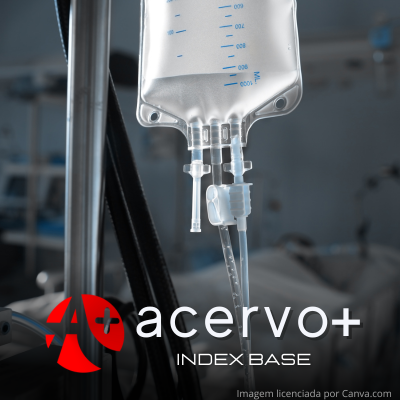Delirium na Unidade de Terapia Intensiva
##plugins.themes.bootstrap3.article.main##
Resumo
Objetivo: Analisar as características do delirium na Unidade de Terapia Intensiva (UTI). Revisão bibliográfica: O delirium, uma forma de disfunção cerebral aguda, é um problema comum e complexo na (UTI), sendo caracterizado como uma perturbação que se desenvolve em um curto período de tempo, flutua e representa uma mudança aguda da atenção e consciência básicas. A incidência de delirium na UTI varia de 45 a 87% e a maior taxa de incidência é encontrada em pacientes de UTI submetidos à ventilação mecânica atingindo mais de 80%. O delirium pode se apresentar como estados hiperativos ou hipoativos e pode flutuar entre os dois como delirium misto. Considerações finais: O delirium é um grave problema na UTI e está associado a resultados adversos como maior mortalidade, maior tempo de internação, maiores custos e maior declínio cognitivo pós internação. Dessa forma, a prevenção e o tratamento do delirium perpassam pela identificação e eliminação dos fatores de risco potenciais e em intervenções não farmacológicas, sendo o tratamento aplicado de forma limitada no tempo e na menor dose possível para o manejo de sintomas altamente estressantes ou comportamento de alto risco.
##plugins.themes.bootstrap3.article.details##
Copyright © | Todos os direitos reservados.
A revista detém os direitos autorais exclusivos de publicação deste artigo nos termos da lei 9610/98.
Reprodução parcial
É livre o uso de partes do texto, figuras e questionário do artigo, sendo obrigatória a citação dos autores e revista.
Reprodução total
É expressamente proibida, devendo ser autorizada pela revista.
Referências
2. BOEHM LM, et al. Delirium-related distress in the ICU: A qualitative meta-synthesis of patient and family perspectives and experiences. Int J Nurs Stud, 2021; 122: 104030.
3. BOWMAN EML, et al. Phenotypes and subphenotypes of delirium: a review of current categorisations and suggestions for progression. Crit Care, 2021; 25(1): 334.
4. BURRY L, et al. Pharmacological interventions for the treatment of delirium in critically ill adults. Cochrane Database Syst Rev, 2019; 9(9): CD011749.
5. BURRY LD, et al. Pharmacological and non-pharmacological interventions to prevent delirium in critically ill patients: a systematic review and network meta-analysis. Intensive Care Med, 2021; 47(9): 943-960.
6. BURTON JK, et al. Non-pharmacological interventions for preventing delirium in hospitalised non-ICU patients. Cochrane Database Syst Rev, 2021; 7(7): CD013307.
7. CAMPBELL NL, et al. Deprescribing in the Pharmacologic Management of Delirium: A Randomized Trial in the Intensive Care Unit. J Am Geriatr Soc, 2019; 67(4): 695-702.
8. CHA S, BROWN CH 4TH. Treating delirium in the intensive care unit: No easy answers. J Thorac Cardiovasc Surg, 2020; 159(5): 1895-1898.
9. DEVLIN JW, et al. Clinical Practice Guidelines for the Prevention and Management of Pain, Agitation/Sedation, Delirium, Immobility, and Sleep Disruption in Adult Patients in the ICU. Crit Care Med, 2018; 46(9): e825-e873.
10. GOULART TL, et al. A eficácia da melatonina na prevenção do delirium em pacientes hospitalizados: uma revisão integrativa, Revista Eletrônica Acervo Médico, 2022; 10: e10410.
11. HERLING SF, et al. Interventions for preventing intensive care unit delirium in adults. Cochrane Database Syst Rev, 2018; 11(11): CD009783.
12. KHAN BA, et al. Biomarkers of Delirium Duration and Delirium Severity in the ICU. Crit Care Med, 2020; 48(3): 353-361.
13. KOTFIS K, et al. ICU delirium - a diagnostic and therapeutic challenge in the intensive care unit. Anaesthesiol Intensive Ther, 2018; 50(2): 160-167.
14. KOTFIS K, et al. The future of intensive care: delirium should no longer be an issue. Crit Care, 2022; 26(1): 200.
15. KUKOLJA J, KUHN J. SOP: treatment of delirium. Neurol Res Pract, 2021; 3(1): 12.
16. LIMA HB, SILVA JN. Incidência do delirium em função da internação em Unidade de Terapia Intensiva: uma revisão integrativa da literatura. Brazilian Journal of Health Review, 2022; 5(3): 8349-8360.
17. MART MF, et al. Prevention and Management of Delirium in the Intensive Care Unit. Semin Respir Crit Care Med, 2021; 42(1): 112-126.
18. PALAKSHAPPA JA, HOUGH CL. How We Prevent and Treat Delirium in the ICU. Chest, 2021; 160(4): 1326-1334.
19. PRENDERGAST NT, et al. Treatment of Delirium During Critical Illness. Annu Rev Med, 2022; 73: 407-421.
20. ROSA RG, et al. Effect of Flexible Family Visitation on Delirium Among Patients in the Intensive Care Unit: The ICU Visits Randomized Clinical Trial. JAMA, 2019; 322(3): 216-228.
21. SIEBER M, et al. Outcome, demography and resource utilization in ICU Patients with delirium and malignancy. Sci Rep, 2021; 11(1): 18756.
22. SILVA MHO, et al. Delirium na terapia intensiva: fatores predisponentes e prevenção de eventos adversos. Rev baiana enferm, 2018; 32: e26031.
23. SOUZA TL, et al. Cuidados multiprofissionais para pacientes em delirium em terapia intensiva: revisão integrativa. Revista Gaúcha de Enfermagem, 2018; 39: e2017-0157.
24. STOLLINGS JL, et al. Delirium in critical illness: clinical manifestations, outcomes, and management. Intensive Care Med, 2021; 47(10): 1089-1103.
25. VASILEVSKIS EE, et al. The Cost of ICU Delirium and Coma in the Intensive Care Unit Patient. Med Care, 2018; 56(10): 890-897.
26. WASSENAAR A, et al. Delirium prediction in the intensive care unit: comparison of two delirium prediction models. Crit Care, 2018; 22(1): 114.
27. WILSON JE, et al. Delirium. Nat Rev Dis Primers, 2020; 6(1): 90.
28. ZHANG S, et al. Effectiveness of Bundle Interventions on ICU Delirium: A Meta-Analysis. Crit Care Med, 2021; 49(2): 335-346.

